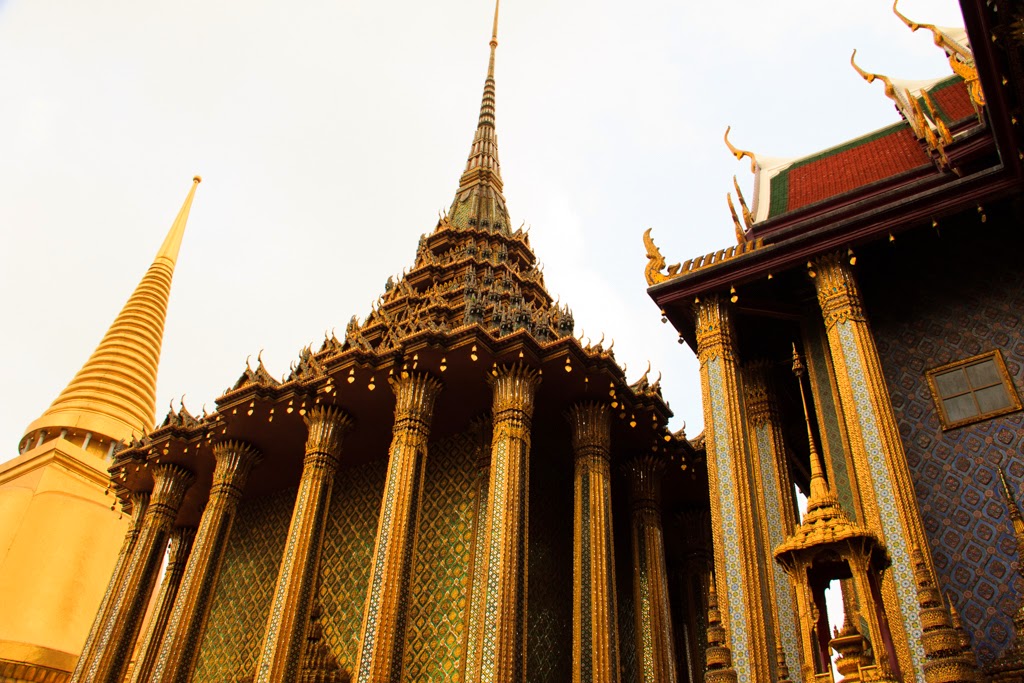Yesterday I travelled from Beijing to Bangkok. As we descended into Bangkok I was greeting by views of lush green vegetation. The skies rolled with big white clouds where the afternoon sun was reflecting shades of pink and orange.
Traffic in Bangkok in the late afternoon was very heavy. My driver told me it is like that from about 5:00 till about 9:00, as the many working people who can't afford to live in the city commute to the outlying areas, sound familiar?
Bangkok is bustling. Cars, motorbikes, scooters, bicycles, pedestrians and tuktuks (small three-wheeled motorized gold car-like vehicles that can transport up to 6 people).
And it is much easier to communicate with people, English is well used and understood by most of the people I encountered.
So, today off for a tour around Bangkok. Today is about exploring the Temples of Bangkok and learning a bit about the country and its history. There is a group of 19 of us, mostly from the US, plus me and one lady from Australia. Our guides are Pon and Pui and husband and wife team eager to show us their country.
Starbucks in hand we board the vans and travel first to The Grand Palace. This is the holiest of the temples and houses the Emerald Buddha, a small (29 inches high) buddha made from the finest jade.
The Grand Palace is really a complex of many towers and buildings, clustered together. It is almost overkill. One lavish, golden, carved building after another with intricately carved spires reaching to the sky. There is the Temple of 4 Kings with its 4 spires, one for each of the first four kings (Rama I, RamaII, Rama III, and Rama IV).
There is the sprawling Palace has been the official residence of the Kings of Siam and later Thailand since 1782. It was where the king, his court and his royal government resided until 1925 and is still used for official events and ceremonies. It was built by King Rama I who founded the Chakri Dynasty and moved the capital to Bangkok.
The complex is 2,351,000 square feet surrounded by four walls. It is made up of a number of buildings, halls and pavilions with gardens and courtyards. Central is the Temple of the Emerald Buddha.
Apparently Rama V was instrumental in modernizing Thailand in the late 1800's, early 1900's. He travelled to Europe and brought back European ideas and technologies and was able to maintain Thailand's strength. He was able to retain their important culture and traditions while developing important political and trade relationships with Europe and the West. Hence, Thailand is a country that has never been dominated or ruled by any other power or country. The word Thai meaning Free, for just that reason.
Next stop was Wat Pho, Temple of the Reclining Buddha. It is about 250 years old built by King Rama I. It was originally the centre of education for traditional Thai medicine including massage and yoga. It was later used to bring together modern medicine with the ancient Chinese and Thai medicine. It is considered the firs public university in Thailand.
Wat Pho houses the Reclining Buddha, a huge golden statue of a Buddha lying down. It is 150 feet long and 50 feet high. The bottoms of the feet are carved with inlaid mother of pearl in intricate depictions.
Lunch at the Riverside Restaurant watching the Thai long-tail boats go by. Thus is a unique boat that uses a standard automotive engine and is designed to carry passengers on a river. It has a long canoe type hull and, often, a canopy. The best spring rolls EVER! And, for dessert mango with black sticky rice and coconut ice cream... to die for!
And finally, The Golden Buddha, the largest golden Buddha image in the world, made of pure 18 karat gold and weighing five and half tons. It sits 15 feet high and 12 1/2 ft wide. The value of the gold is estimated at 28.5 million pounds. The Buddha is about 700 years old.
Originally the image was completely covered with plaster to conceal its value from invading forces. The statue was moved several times. In 1955 when moving it again pieces of plaster cracked off and the solid gold statue underneath was discovered. In 2010 a beautiful new temple was built to house the precious monument, where it sits today.
A walk though Chinatown with its market of fruits, vegetables, spices and Chinese trinkets and it was time to call it a day.!
monks wear bright orange robes. I couldn't believe how young some of them were.
I feel I have learned a bit of the Thai history and culture. They are a gentle people with strong traditions and culture and real strong devotion to there king and country. I like it here.
Tomorrow ..... the markets! Come with me......





















No comments:
Post a Comment